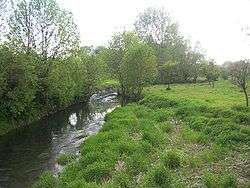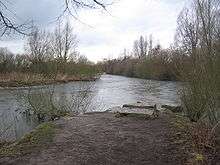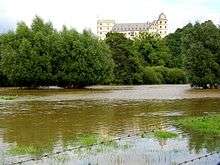Alme (river)
The Alme is a 59-kilometre (37 mi) long river in North Rhine-Westphalia, Germany. It is a left tributary of the Lippe, into which it flows near Paderborn. The Alme defines the Alme Valley and flows through the towns Büren, Borchen and Paderborn.
| Alme | |
|---|---|
 | |
| Location | |
| Country | Germany |
| Physical characteristics | |
| Source | |
| • location | Sauerland |
| • elevation | ±340 m (1,120 ft) |
| Mouth | |
• location | Lippe |
• coordinates | 51°44′55″N 8°42′25″E |
| Length | 59.4 km (36.9 mi) [1] |
| Basin size | 763 km2 (295 sq mi) [1] |
| Basin features | |
| Progression | Lippe→ Rhine→ North Sea |

History
Flood of 1965
In July 1965 a devastating flood occurred, which became part of regional history as a once-in-a-hundred-years flooding and is remembered by locals as the "Heinrichsflut"[2] (Henry's Day Flood). After heavy rainfalls from July 15 through to 17 (more than 135 l/m2),[3] basements were flooded. In the village of Wewelsburg a bridge collapsed, an Army sapper unit had to be brought in for disaster relief. Streets turned into river beds, railway and bus traffic had to be stopped, 16 people died.[4] As a consequence of the flood, which also took in the tributaries of the Alme and the Lippe river itself, the "Wasserverband Obere Lippe"[5] (board for basin management of the upper Lippe river) was founded, one of whose aims is to prevent or mitigate any damage that may be caused by further floods mainly by way of building detention basins.
Flood of 2007

On August 22, 2007 the Alme river burst its banks around the town of Büren, after heavy rainfalls of some 70 l/m2 in the course of one night. In the village of Weine the flood level exceeded that of 1965. Even though the flood was less sweeping in effect than the "Heinrichsflut",[6] schools in Büren had to finish early and send the pupils home, some streets became impassable. 220 local firefighters supported by emergency response units of THW, DLRG and DRK were deployed to clear out flooded basements or to protect houses in low grounds by stacked sandbags.
References
- Hydrographic Directory of the NRW State Office for Nature, the Environment and Consumer Protection (Gewässerverzeichnis des Landesamtes für Natur, Umwelt und Verbraucherschutz NRW 2010) (xls; 4.67 MB)
- "Heinrichsflut" on German Wikipedia [last retrieved on 2018-07-22]
- Der Spiegel from 1965-07-28 (German only; last retrieved on 2018-07-22)
- This number includes not only the casualties in Alme, Altenau and Lippe area, but all victims in the disaster area, which extended as far as Thüringen, Sachsen-Anhalt, and Saxony. See "Heinrichsflut" on German Wikipedia; cf. "Heinrichsflut" on the Website of German Weather Service DWD (only in German) [last retrieved on 2018-07-22] The death toll in the region is given as 11 on German Wikipedia in the article "Wasserverband Obere Lippe"
- "Der Wasserverband Obere Lippe (WOL) wurde 1971 von den damaligen Kreisen Büren, Paderborn und Lippstadt als Reaktion auf die Heinrichsflut vom 16.-17. Juli 1965 gegründet." (retrieved from http://www.wol-nrw.de/ 2018-07-22)
- see paragraph above or entry "Heinrichsflut" on German Wikipedia